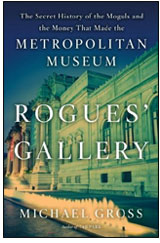Books |
Rogues’ Gallery: The Secret Story of the Lust, Lies, Greed, and Betrayals that Made the Metropolitan Museum of Art
Michael Gross
By
Published: Apr 29, 2009
Category:
Non Fiction
Reading an independent, unauthorized history of the Metropolitan Museum of Art is like taking a guided tour of a sausage factory — if you like to enjoy the product, it’s best not to see how it’s manufactured.
Great art is made by great artists in a process that bounces between exaltation and blue-collar labor, but everything that happens between the minute the canvas dries and the painting is displayed in a museum is made with money. Lots of it. Money to buy art. Money to build galleries. Money that comes from rich people — and not just any billionaire, but the “right” kind. You know: first generation Jewish money, suspect Russian money, and all Middle Eastern money need not apply.
The Met is the greatest museum in this hemisphere, with two million art objects stored in two million square feet of the choicest real estate in Central Park — if you had to put a price tag on it, think $300 to $400 billion. To be a Trustee is the pinnacle of Society. And that’s a social and economic hurdle which scares most writers. Whatever they say about the museum or its benefactors, they want to be asked back for lunch. So, more often than not, anything they write about the rich and privileged is a mere shadow of the book or article they could have written. No foul — it’s just the way life works. As Somerset Maugham noted, “I do not think you want too much sincerity in Society. It would be like an iron girder in a house of cards.”
Michael Gross has written a series of books that guarantee he won’t be asked back to lunch. In Rogues’ Gallery: The Secret History of the Moguls and the Money that Made the Metropolitan Museum, he begins gently, presenting a dignified, to-my-eye authoritative history of the museum. But I don’t care about the dead rich who funded and ran the place — I came for the dish about the living. I therefore skimmed the first 200 pages and suggest that you do the same.
Once you get to Thomas Hoving, the showman who brought the Met into the Modern Age, the book becomes fascinating. Scandalously so, for we’re no longer dealing with New York’s sedate “Old Money” crowd. Now we have Charles Wrightsman, who liked to flip silver dollars into the pool and watch his guests dive for them. And Brooke Astor, now a saint, but back when she snared Vincent Astor, Hoving saw her dancing alone — with joy — in her living room. We get enough collusion between the museum’s de-accessioning practices and a favored art dealer for the Met to be dubbed Marlborough Country. (A New York Times reporter who traced the museum’s malfeasance suddenly found himself writing about food.)
Diana Vreeland, while working at the Met, also cashed checks from Kay Graham and Jane Engelhard for her services as a personal shopper. Annette de la Renta, now the Queen of New York, was once a 160-pound wild child; Oscar de la Renta abandoned a woman who’d launched his social and business career, inspiring her to sue him. Alfred Taubman’s money had so many strings attached he was told to get lost. When the Temple of Dendur was opened, the museum had, at last, a giant party space — “Club Met”. Michael Gross wields a wicked pen; this is Dominick Dunne territory.
It is perhaps the greatest achievement of Philippe de Montebello, the charming director who recently retired, that so little of the behind-the-scenes machinations has surfaced. For these rich supporters, as a disgruntled semi-rich observer has noted, “run the museum to settle scores and control New York society as much to exhibit art.” And they do it for a very simple reason — they have no other work. They’re rich, spoiled and bored. Art is what they graduate to after they’ve finished pulling the wings off flies.
Reading this book gave me the idea for a parlor game: Who should paint the portraits of the Met’s greatest trustees? At first I thought: Lucian Freud. But by the time I finished “Rogues’ Gallery”, I was quite sure it should be Francis Bacon.
To buy “Rogues’ Gallery” from Amazon.com, click here.
To read about “740 Park Avenue”, by Michael Gross, on HeadButler.com, click here.
To visit Michael Gross’s website and blog, click here.


